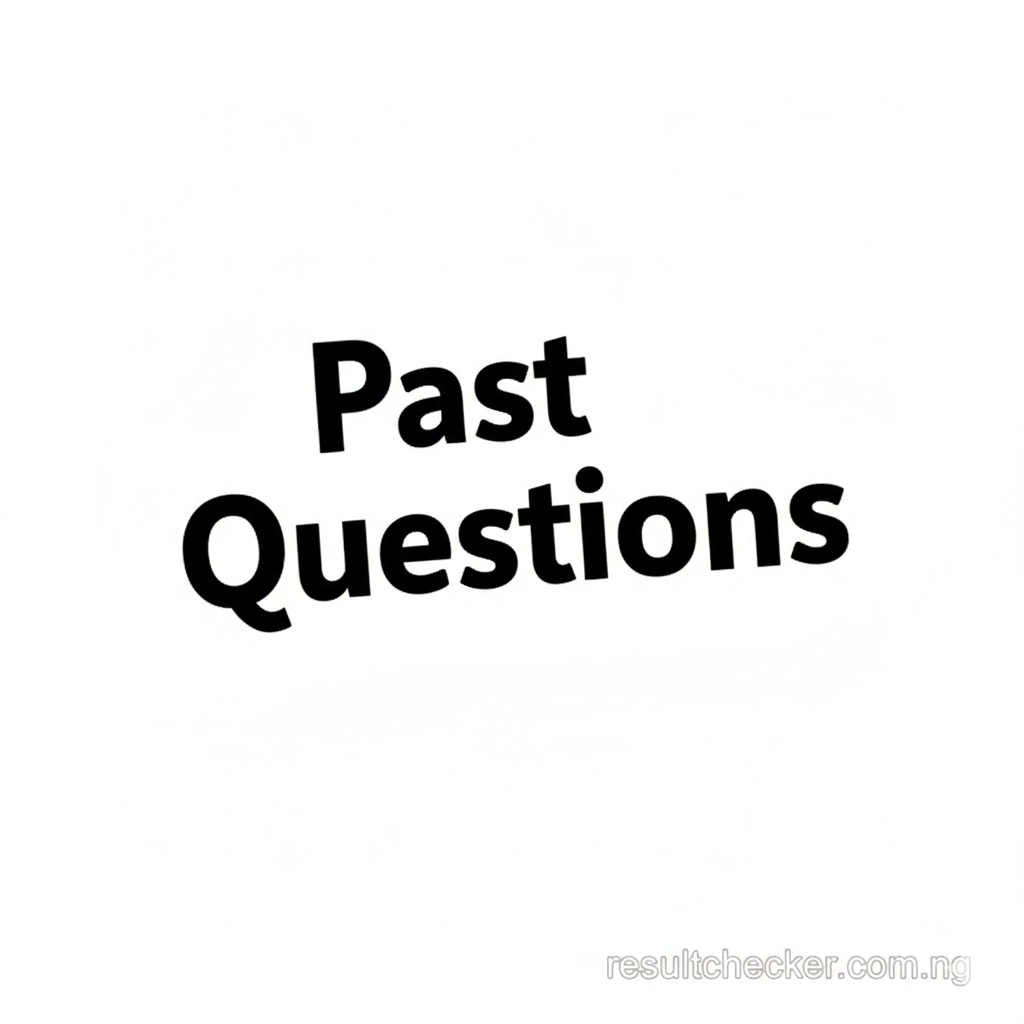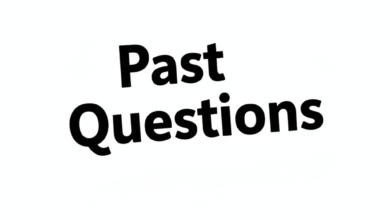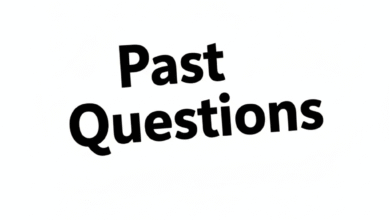JAMB Economics Past Questions and Answers (50 Practice Questions)

JAMB Economics Past Questions, Preparing for the JAMB Economics exam requires a solid understanding of key concepts and the ability to solve problems quickly and accurately. One of the best ways to prepare is by practicing with past questions. This helps you understand the exam format, identify frequently tested topics, and improve your speed.
Below are 50 likely Economics questions, complete with answers and calculations, to help you practice.
Disclaimer: These questions are for practice purposes only and are designed to be similar to what you might encounter in the JAMB UTME.
Section 1: Fundamentals of Economics
1. Economics is a social science that studies human behavior as a relationship between ends and scarce means which have alternative uses. This definition was given by? (A) Adam Smith (B) John Maynard Keynes (C) Lionel Robbins (D) Alfred Marshall
Answer: (C) Lionel Robbins
2. The fundamental problem of economics is? (A) The allocation of resources (B) The problem of scarcity and choice (C) The problem of economic growth (D) The problem of inflation
Answer: (B) The problem of scarcity and choice
3. A production possibility curve (PPC) that is bowed outwards illustrates? (A) Decreasing opportunity cost (B) Increasing opportunity cost (C) Constant opportunity cost (D) Zero opportunity cost
Answer: (B) Increasing opportunity cost
4. Which of the following is NOT a basic economic question? (A) What to produce? (B) How to produce? (C) For whom to produce? (D) When to produce?
Answer: (D) When to produce?
5. In a capitalist economy, the question of what to produce is primarily determined by? (A) The government (B) The price mechanism (C) Traditional rulers (D) The central bank
Answer: (B) The price mechanism
6. A point inside the production possibility curve indicates? (A) Full employment of resources (B) Unattainable production level (C) Underutilization or unemployment of resources (D) Economic growth
Answer: (C) Underutilization or unemployment of resources
Section 2: Microeconomics: Theory of Demand and Supply
7. An exceptional demand curve is one that slopes? (A) Upwards from left to right (B) Downwards from left to right (C) Horizontally (D) Vertically
Answer: (A) Upwards from left to right
8. If the price of commodity X falls and the quantity demanded of commodity Y also falls, then X and Y are? (A) Complementary goods (B) Substitute goods (C) Giffen goods (D) Inferior goods
Answer: (B) Substitute goods
9. The law of diminishing marginal utility states that? (A) Total utility always decreases (B) As more of a commodity is consumed, the satisfaction derived from each additional unit decreases (C) Marginal utility is always negative (D) Average utility is the same as marginal utility
Answer: (B) As more of a commodity is consumed, the satisfaction derived from each additional unit decreases
10. A shift in the demand curve to the right indicates? (A) A decrease in demand (B) An increase in demand (C) An extension in demand (D) A contraction in demand
Answer: (B) An increase in demand
11. If the quantity demanded of a product is 50 units when the price is ₦10, and it increases to 60 units when the price falls to ₦8, what is the price elasticity of demand? (A) 1.5 (B) 2.0 (C) 1.0 (D) 0.5
Answer: (C) 1.0
- Calculation:
- Price Elasticity of Demand (PED) = (% Change in Quantity Demanded) / (% Change in Price)
- % Change in Quantity Demanded = [(New Quantity – Old Quantity) / Old Quantity] * 100 = [(60 – 50) / 50] * 100 = (10 / 50) * 100 = 20%
- % Change in Price = [(New Price – Old Price) / Old Price] * 100 = [(8 – 10) / 10] * 100 = (-2 / 10) * 100 = -20%
- PED = 20% / -20% = -1.0. (We ignore the negative sign for PED, so the answer is 1.0)
12. When the supply of a commodity is fixed, its price elasticity of supply is? (A) Perfectly elastic (B) Perfectly inelastic (C) Unitary elastic (D) Fairly elastic
Answer: (B) Perfectly inelastic
13. A market is in equilibrium when? (A) Quantity supplied is greater than quantity demanded (B) Quantity demanded is equal to quantity supplied (C) Quantity demanded is greater than quantity supplied (D) The price is at its highest point
Answer: (B) Quantity demanded is equal to quantity supplied
14. A minimum price set by the government above the equilibrium price is known as a? (A) Price ceiling (B) Price floor (C) Equilibrium price (D) Market price
Answer: (B) Price floor
15. If the demand function is Qd = 40 – 2P and the supply function is Qs = 10 + 3P, find the equilibrium price. (A) ₦5 (B) ₦6 (C) ₦8 (D) ₦10
Answer: (B) ₦6
- Calculation:
- In equilibrium, Quantity Demanded (Qd) = Quantity Supplied (Qs).
- 40 – 2P = 10 + 3P
- Collect like terms: 40 – 10 = 3P + 2P
- 30 = 5P
- Divide both sides by 5: P = 30 / 5
- P = ₦6
Section 3: Production and Cost
16. Which of the following is NOT a factor of production? (A) Land (B) Labour (C) Capital (D) Money
Answer: (D) Money
17. The reward for capital as a factor of production is? (A) Rent (B) Wages (C) Interest (D) Profit
Answer: (C) Interest
18. Production is said to be complete when? (A) Goods are produced in the factory (B) Goods reach the wholesaler (C) Goods reach the final consumer (D) Goods are sold to the retailer
Answer: (C) Goods reach the final consumer
19. Total Cost (TC) is the sum of? (A) Marginal Cost and Average Cost (B) Total Fixed Cost and Total Variable Cost (C) Average Fixed Cost and Average Variable Cost (D) Marginal Cost and Total Fixed Cost
Answer: (B) Total Fixed Cost and Total Variable Cost
20. If the total cost of producing 10 units of a good is ₦100 and the total cost of producing 11 units is ₦115, the marginal cost of the 11th unit is? (A) ₦10 (B) ₦15 (C) ₦100 (D) ₦115
Answer: (B) ₦15
- Calculation:
- Marginal Cost (MC) = Change in Total Cost (ΔTC) / Change in Quantity (ΔQ)
- MC = (TC₂ – TC₁) / (Q₂ – Q₁)
- MC = (₦115 – ₦100) / (11 – 10)
- MC = ₦15 / 1
- MC = ₦15
21. The law of diminishing returns applies to the? (A) Long run (B) Short run (C) Market period (D) Secular period
Answer: (B) Short run
22. A firm’s average cost is calculated by dividing? (A) Total cost by total output (B) Total cost by marginal output (C) Marginal cost by total output (D) Total variable cost by total output
Answer: (A) Total cost by total output
23. Which of these curves is U-shaped? (A) The Average Fixed Cost curve (B) The Marginal Product curve (C) The Average Cost curve (D) The Total Cost curve
Answer: (C) The Average Cost curve
Section 4: Market Structures
24. A market structure where there is only one seller of a commodity is known as? (A) Perfect competition (B) Oligopoly (C) Monopoly (D) Monopolistic competition
Answer: (C) Monopoly
25. A key feature of a perfectly competitive market is that? (A) Firms are price makers (B) There are barriers to entry (C) Products are heterogeneous (D) Firms are price takers
Answer: (D) Firms are price takers
26. In the long run, a firm in a perfectly competitive market makes? (A) Supernormal profit (B) Normal profit (C) A loss (D) Monopoly profit
Answer: (B) Normal profit
27. The main difference between a monopoly and monopolistic competition is? (A) The number of sellers (B) The nature of the product (homogeneous vs. differentiated) (C) The shape of the demand curve (D) The presence of advertising
Answer: (B) The nature of the product (homogeneous vs. differentiated)
28. An oligopolistic market is characterized by? (A) Many firms (B) A single firm (C) A few dominant firms (D) No competition
Answer: (C) A few dominant firms
29. The demand curve faced by a monopolist is? (A) Perfectly elastic (B) Downward sloping (C) Perfectly inelastic (D) Upward sloping
Answer: (B) Downward sloping
Section 5: Macroeconomics: National Income
30. National income is the total value of? (A) All goods and services produced in a country in a year (B) All money in circulation (C) All government revenue (D) All imports and exports
Answer: (A) All goods and services produced in a country in a year
31. Gross Domestic Product (GDP) is different from Gross National Product (GNP) because of? (A) Depreciation (B) Net factor income from abroad (C) Indirect taxes (D) Subsidies
Answer: (B) Net factor income from abroad
32. Which of the following is NOT a method of measuring national income? (A) The income method (B) The expenditure method (C) The output method (D) The inflation method
Answer: (D) The inflation method
33. Disposable income is Personal Income? (A) Plus direct taxes (B) Minus direct taxes (C) Plus subsidies (D) Minus indirect taxes
Answer: (B) Minus direct taxes
34. If a country’s GDP is ₦500 billion and its net factor income from abroad is -₦20 billion, what is its GNP? (A) ₦520 billion (B) ₦480 billion (C) ₦500 billion (D) ₦20 billion
Answer: (B) ₦480 billion
- Calculation:
- Gross National Product (GNP) = Gross Domestic Product (GDP) + Net Factor Income from Abroad (NFIA)
- GNP = ₦500 billion + (-₦20 billion)
- GNP = ₦500 billion – ₦20 billion
- GNP = ₦480 billion
35. A period of persistent rise in the general price level is known as? (A) Deflation (B) Inflation (C) Reflation (D) Stagflation
Answer: (B) Inflation
36. The value of money is most affected by? (A) The interest rate (B) The price level (C) The exchange rate (D) The employment rate
Answer: (B) The price level
Section 6: Money, Banking, and Public Finance
37. The function of money that allows us to compare the value of different goods is? (A) Medium of exchange (B) Store of value (C) Unit of account / Measure of value (D) Standard of deferred payment
Answer: (C) Unit of account / Measure of value
38. The central bank of a country is often described as the? (A) Commercial bank (B) Lender of last resort (C) Development bank (D) Merchant bank
Answer: (B) Lender of last resort
39. Which of the following is NOT a function of the central bank? (A) Issuing currency (B) Controlling the money supply (C) Providing personal loans to individuals (D) Acting as the government’s banker
Answer: (C) Providing personal loans to individuals
40. Public finance is the study of? (A) The finances of individuals (B) The finances of business firms (C) The revenue and expenditure of the government (D) The operations of the stock market
Answer: (C) The revenue and expenditure of the government
41. The main source of government revenue in Nigeria is? (A) Agriculture (B) Taxation from petroleum (C) Company income tax (D) Customs duties
Answer: (B) Taxation from petroleum
42. A tax system where the tax rate increases as income increases is called? (A) Proportional tax (B) Progressive tax (C) Regressive tax (D) Value Added Tax
Answer: (B) Progressive tax
43. The government budget is a statement of? (A) Planned revenue and expenditure for the coming year (B) Actual revenue and expenditure for the past year (C) The country’s total debt (D) The country’s foreign exchange reserves
Answer: (A) Planned revenue and expenditure for the coming year
44. If the government’s total expenditure is greater than its total revenue, it has a? (A) Budget surplus (B) Balanced budget (C) Budget deficit (D) National debt
Answer: (C) Budget deficit
45. Which of the following is an example of a direct tax? (A) Value Added Tax (VAT) (B) Customs duties (C) Personal Income Tax (D) Excise duties
Answer: (C) Personal Income Tax
Section 7: International Trade and Economic Development
46. The theory of comparative advantage was propounded by? (A) Adam Smith (B) David Ricardo (C) John Stuart Mill (D) Thomas Malthus
Answer: (B) David Ricardo
47. A tariff is a tax imposed on? (A) Exports (B) Imports (C) Domestically produced goods (D) Services
Answer: (B) Imports
48. A country’s balance of payments is a record of its? (A) Total government spending (B) Total domestic production (C) Economic transactions with the rest of the world (D) Total money supply
Answer: (C) Economic transactions with the rest of the world
49. An improvement in a country’s terms of trade means that? (A) Export prices have risen relative to import prices (B) Import prices have risen relative to export prices (C) The volume of exports has increased (D) The volume of imports has decreased
Answer: (A) Export prices have risen relative to import prices
50. The main objective of the Economic Community of West African States (ECOWAS) is to? (A) Promote military cooperation (B) Promote economic integration and cooperation (C) Establish a single currency (D) Promote cultural exchange
Answer: (B) Promote economic integration and cooperation


